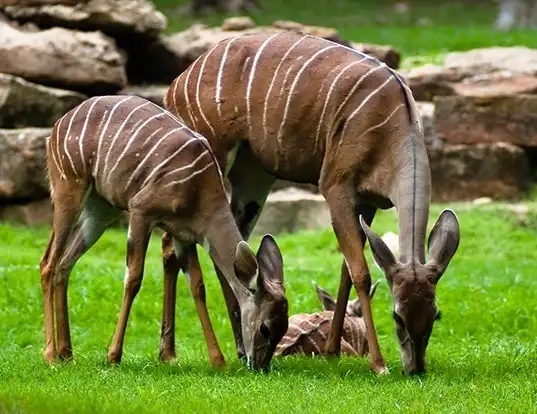
Lesser Kudu: The Elegant Antelope of East Africa
The lesser kudu (Tragelaphus imberbis) stands as a majestic symbol of East Africa’s diverse wildlife, adorned with striking spiral horns and a graceful demeanor. In this exploration, we embark on a journey into the natural habitat and unique characteristics of the lesser kudu, uncovering the intricacies of its behavior, habitat preferences, and the conservation challenges it faces in the wild.
Introduction: Nestled amidst the acacia woodlands and scrub forests of East Africa, the lesser kudu emerges as a charismatic inhabitant of the region’s iconic savannas. With its distinctive appearance and elusive nature, this antelope species captivates the hearts of wildlife enthusiasts and conservationists alike, offering a glimpse into the rich tapestry of Africa’s biodiversity.
Appearance and Behavior: Characterized by its reddish-brown coat, white stripes, and spiral horns, the lesser kudu exudes an air of elegance as it gracefully navigates through its habitat. Despite its name, the lesser kudu is by no means diminutive, standing tall with a height of up to 100 centimeters at the shoulder. Renowned for its agility and speed, it possesses remarkable leaping abilities, enabling it to traverse rugged terrain with ease.

Habitat and Range: The lesser kudu is predominantly found in the arid and semi-arid regions of East Africa, including countries such as Kenya, Tanzania, and Ethiopia. It favors habitats characterized by dense vegetation, rocky outcrops, and sparse tree cover, where it can seek refuge from predators and browse on a variety of plants. However, habitat loss and fragmentation pose significant threats to its survival, as human activities encroach upon its natural range.
Diet and Feeding Behavior: As a browser, the lesser kudu feeds on a diverse array of leaves, shoots, fruits, and flowers, supplementing its diet with grasses during periods of scarcity. Its browsing habits are influenced by seasonal variations in food availability, prompting it to migrate in search of greener pastures during the dry season. Despite its herbivorous diet, the lesser kudu faces competition for resources from livestock and other herbivores, exacerbating its vulnerability to habitat degradation.
Conservation Status and Challenges: The lesser kudu is classified as “Near Threatened” by the International Union for Conservation of Nature (IUCN), with populations declining due to habitat loss, poaching, and human-wildlife conflict. Efforts to conserve this iconic species involve habitat protection, anti-poaching measures, and community-based conservation initiatives aimed at promoting coexistence between humans and wildlife.
Conclusion: In the vast landscapes of East Africa, the lesser kudu reigns as a symbol of resilience and adaptability, embodying the spirit of the continent’s untamed wilderness. By recognizing the importance of conserving its habitat and addressing the challenges it faces, we can ensure a future where the lesser kudu continues to roam free, enriching our lives with its presence and inspiring generations to come.






